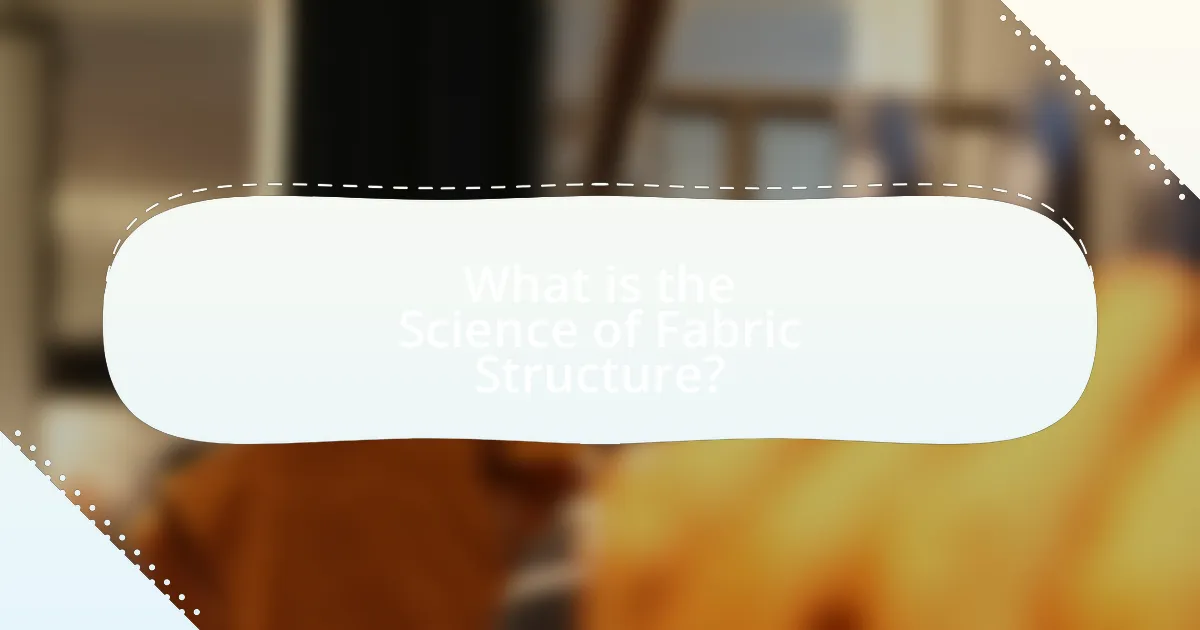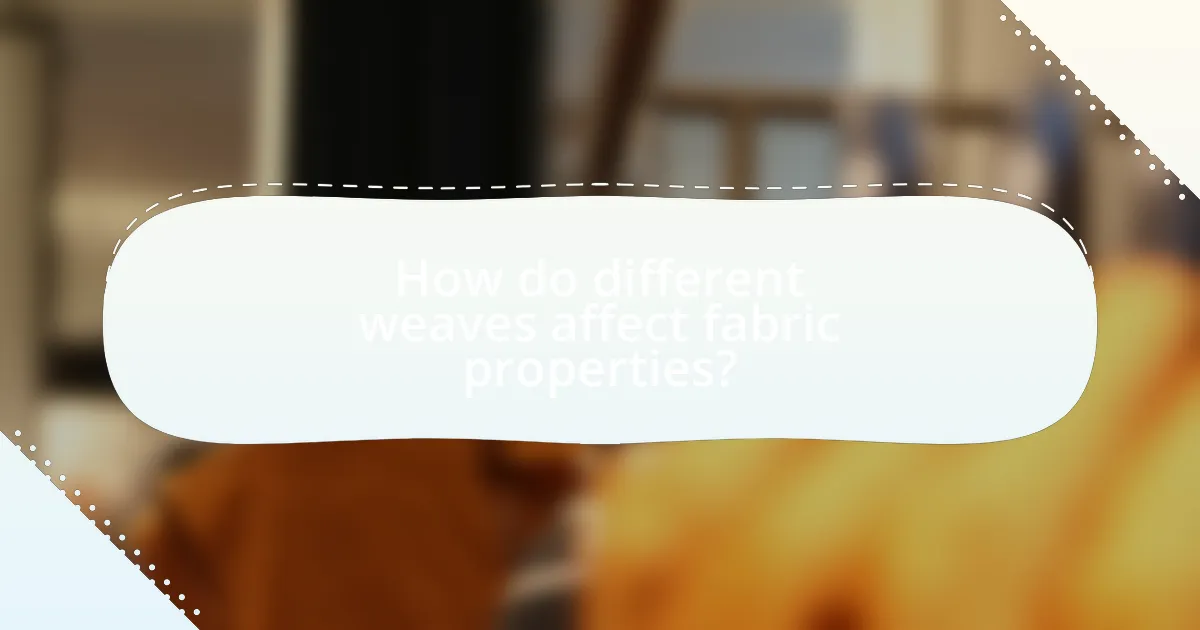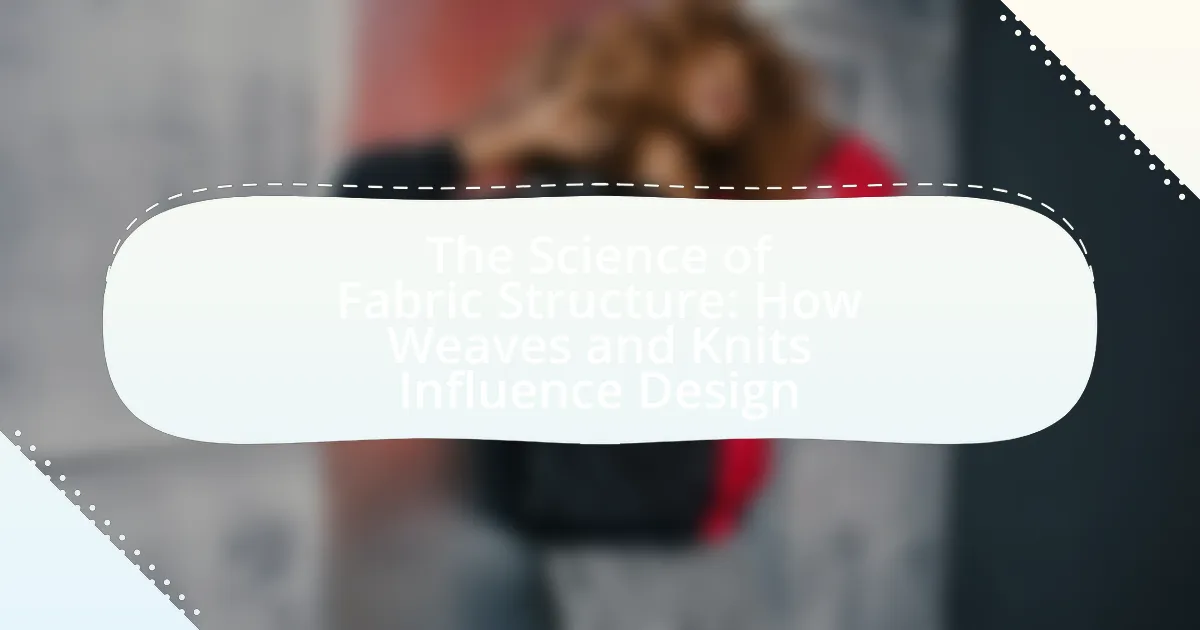The article focuses on the science of fabric structure, specifically examining how different weaving and knitting techniques impact the properties and performance of textiles. It outlines the fundamental differences between woven and knitted fabrics, detailing how their construction affects characteristics such as strength, flexibility, and texture. Key principles of weaving, including various weave types like plain, twill, and satin, are discussed, along with their implications for durability and aesthetic appeal. Additionally, the article explores the influence of knit structures on elasticity and design applications, highlighting best practices for designers in selecting appropriate fabric structures to meet functional and aesthetic requirements.

What is the Science of Fabric Structure?
The science of fabric structure involves the study of how different weaving and knitting techniques affect the properties and performance of textiles. This field examines the relationships between yarn types, fabric construction methods, and the resulting characteristics such as strength, flexibility, and texture. For instance, woven fabrics typically exhibit greater durability due to their interlaced structure, while knitted fabrics offer more stretch and comfort due to their looped formation. Understanding these principles is crucial for designers and manufacturers in creating textiles that meet specific functional and aesthetic requirements.
How do weaves and knits differ in fabric construction?
Weaves and knits differ in fabric construction primarily in their method of interlacing yarns. Weaves are created by interlacing two sets of yarns at right angles, typically resulting in a stable and structured fabric, while knits are formed by looping a single yarn in a series of interconnected stitches, which provides stretch and flexibility. This fundamental difference in construction leads to distinct characteristics: woven fabrics tend to be more durable and less elastic, making them suitable for tailored garments, whereas knitted fabrics are softer and more elastic, ideal for casual wear and active clothing.
What are the fundamental principles of weaving?
The fundamental principles of weaving include the interlacing of two sets of threads, known as the warp and the weft, to create fabric. The warp threads run lengthwise on the loom, while the weft threads are woven across them. This process relies on specific techniques such as plain weave, twill weave, and satin weave, each producing distinct fabric characteristics. For instance, plain weave is the simplest and most common, providing durability and a flat surface, while twill weave creates a diagonal pattern, enhancing drape and texture. The choice of fibers, thread count, and tension also significantly influence the final fabric’s strength, appearance, and functionality.
How does knitting differ from weaving in terms of structure?
Knitting differs from weaving in terms of structure by creating a fabric through interlocking loops of yarn, while weaving involves the interlacing of two sets of threads at right angles. In knitting, the structure is formed by a series of connected loops, which allows for greater elasticity and stretch, making knitted fabrics more flexible. Conversely, weaving produces a more stable and rigid fabric due to the fixed arrangement of warp and weft threads. This fundamental difference in construction leads to distinct characteristics in the final textile, such as the drape, texture, and durability of the fabric.
Why is fabric structure important in design?
Fabric structure is important in design because it directly influences the aesthetic, functionality, and durability of a product. The way fibers are woven or knitted affects the texture, drape, and overall appearance, which can enhance or detract from the intended design vision. For instance, a tightly woven fabric may provide more durability and resistance to wear, while a loosely knitted fabric can offer greater breathability and comfort. Studies have shown that different fabric structures can alter the thermal properties and moisture management of textiles, impacting user experience and performance in various applications.
How does fabric structure influence the aesthetic of a design?
Fabric structure significantly influences the aesthetic of a design by determining the texture, drape, and visual appeal of the material. Different weaves and knits create distinct surface characteristics; for example, a satin weave produces a smooth, glossy finish that enhances elegance, while a twill weave offers a more textured and durable appearance. The choice of fabric structure affects how light interacts with the material, impacting color perception and overall design harmony. Studies show that fabrics with varied structures can evoke different emotional responses, influencing consumer preferences and perceptions of quality.
What role does fabric structure play in functionality and performance?
Fabric structure significantly influences functionality and performance by determining properties such as strength, flexibility, breathability, and moisture management. For instance, tightly woven fabrics provide durability and resistance to wear, while looser weaves enhance breathability and comfort. Additionally, the choice between knits and wovens affects stretch and recovery, impacting how garments fit and move with the body. Research indicates that specific weave patterns, like twill or satin, can enhance fabric drape and aesthetic appeal, further influencing performance in various applications, from athletic wear to formal attire.

How do different weaves affect fabric properties?
Different weaves significantly affect fabric properties such as texture, strength, drape, and breathability. For instance, a plain weave, characterized by its simple over-and-under pattern, results in a strong and durable fabric, making it ideal for items like shirts and bed linens. In contrast, a twill weave, which features a diagonal pattern, enhances the fabric’s drape and softness, often used in denim and tailored garments. Additionally, a satin weave, known for its smooth surface and luster, provides a luxurious feel but may sacrifice durability. These variations in weave structure directly influence the fabric’s performance and suitability for specific applications, as evidenced by the distinct characteristics of fabrics like canvas, chiffon, and silk.
What are the most common types of weaves?
The most common types of weaves are plain weave, twill weave, and satin weave. Plain weave is characterized by a simple over-and-under pattern, making it strong and durable, commonly used in fabrics like muslin and canvas. Twill weave features a diagonal rib pattern, providing a softer texture and better drape, often found in denim and gabardine. Satin weave, known for its smooth surface and luster, is created by floating warp threads over weft threads, resulting in luxurious fabrics like satin and charmeuse. These weaves are foundational in textile production, influencing the fabric’s appearance, texture, and functionality.
How does a plain weave impact durability and texture?
A plain weave significantly enhances durability and texture in fabrics. This weave structure, characterized by a simple over-and-under pattern, creates a tightly interlaced fabric that resists fraying and wear, making it more robust compared to other weaves. The uniformity of the plain weave also contributes to a smooth texture, providing a flat surface that is less prone to snagging. Studies have shown that fabrics made with plain weaves, such as cotton and linen, exhibit higher tensile strength, which is crucial for longevity in various applications, from clothing to upholstery.
What unique characteristics does a twill weave provide?
A twill weave provides unique characteristics such as diagonal ribbing, enhanced durability, and improved drape. The diagonal pattern results from the weaving technique, where the weft thread passes over one or more warp threads and then under two or more warp threads, creating a distinct texture. This structure not only contributes to the fabric’s strength but also allows for better flexibility and movement, making it suitable for various applications, including clothing and upholstery. Additionally, twill fabrics tend to resist wrinkles and creases better than plain weaves, which enhances their longevity and aesthetic appeal.
How do weaves contribute to the overall design process?
Weaves significantly contribute to the overall design process by determining the texture, appearance, and functionality of fabrics. The choice of weave affects how light interacts with the material, influencing visual aesthetics, such as sheen and pattern. For instance, a satin weave creates a smooth, glossy surface ideal for formal wear, while a twill weave offers durability and a diagonal pattern suitable for workwear. Additionally, different weaves can enhance the fabric’s performance characteristics, such as breathability, stretch, and drape, which are crucial for garment fit and comfort. The interplay between weave structure and design intent is essential, as it allows designers to achieve specific outcomes that align with their creative vision and practical requirements.
What considerations should designers keep in mind when selecting a weave?
Designers should consider the fabric’s intended use, durability, and aesthetic when selecting a weave. The intended use dictates the weave’s functionality; for example, a tighter weave offers more durability for upholstery, while a looser weave may be suitable for lightweight garments. Durability is crucial as it affects the longevity and maintenance of the fabric; fabrics like denim utilize a twill weave for strength. Aesthetic considerations include texture, drape, and visual appeal, which can significantly influence the overall design. For instance, satin weaves create a glossy finish, enhancing the fabric’s elegance.
How can weaves be manipulated to achieve desired effects in design?
Weaves can be manipulated to achieve desired effects in design by altering their structure, density, and pattern. For instance, changing the weave type from plain to twill can create different textures and drape, influencing the overall aesthetic and functionality of the fabric. Additionally, adjusting the thread count can enhance durability and opacity, while incorporating varied yarns can introduce color and pattern variations. These manipulations are supported by textile engineering principles, which demonstrate that specific weave configurations directly affect the fabric’s performance characteristics, such as breathability and stretch.

What are the implications of knit structures in fabric design?
Knit structures significantly influence fabric design by affecting the fabric’s elasticity, drape, and texture. These structures allow for greater flexibility and stretch compared to woven fabrics, enabling designers to create garments that conform to the body’s shape and movement. Additionally, knit fabrics can be produced in various thicknesses and patterns, which enhances aesthetic appeal and functionality. For instance, the use of ribbing in knit structures can provide additional warmth and comfort, making them suitable for activewear and casual clothing. The versatility of knit structures also allows for innovative designs, such as seamless garments, which reduce fabric waste and improve fit.
How do different knitting techniques influence fabric behavior?
Different knitting techniques significantly influence fabric behavior by altering properties such as stretch, drape, and texture. For instance, techniques like ribbing create fabrics with greater elasticity, allowing them to stretch and recover, which is ideal for fitted garments. Conversely, techniques such as garter stitch produce a thicker, more textured fabric that tends to be less elastic and has a distinct visual appearance. Additionally, the use of techniques like lace knitting introduces openwork patterns that affect the fabric’s breathability and overall weight. These variations in knitting methods directly impact how the fabric interacts with the body and the environment, influencing the final design and functionality of the textile.
What are the benefits of using jersey knit versus rib knit?
Jersey knit offers a smoother surface and greater stretch compared to rib knit, making it ideal for fitted garments. The smooth texture of jersey knit enhances comfort and drape, while its elasticity allows for better movement and flexibility in clothing. In contrast, rib knit provides more structure and durability, making it suitable for items that require a tighter fit or more resilience. The choice between the two depends on the desired garment characteristics; jersey knit is preferred for casual wear and layering, while rib knit is often used for cuffs and hems due to its ability to retain shape.
How does the structure of a knit affect stretch and recovery?
The structure of a knit significantly influences its stretch and recovery properties. Knits are composed of interlocking loops of yarn, which allows them to stretch in multiple directions, providing elasticity. The specific arrangement of these loops, such as the gauge and stitch type, determines the extent of stretch; for example, tighter stitches offer less stretch, while looser stitches enhance flexibility. Additionally, the fiber content plays a crucial role; synthetic fibers like spandex contribute to greater recovery, allowing the fabric to return to its original shape after being stretched. Studies have shown that knits with a higher percentage of elastic fibers exhibit superior recovery rates, confirming the relationship between knit structure and performance characteristics.
What are the design applications of knitted fabrics?
Knitted fabrics are utilized in various design applications, including apparel, home textiles, and technical textiles. In apparel, knitted fabrics provide stretch and comfort, making them ideal for garments such as sweaters, t-shirts, and activewear. Home textiles benefit from knitted fabrics in items like blankets, upholstery, and curtains, where texture and warmth are desired. Additionally, technical textiles leverage knitted structures for applications in medical devices, automotive interiors, and sports equipment due to their lightweight and flexible properties. The versatility of knitted fabrics is supported by their ability to be engineered for specific performance characteristics, such as moisture-wicking or thermal insulation, enhancing their functionality across diverse design fields.
How can designers leverage knit structures for innovative designs?
Designers can leverage knit structures for innovative designs by utilizing their inherent flexibility and texture to create unique patterns and forms. The versatility of knit fabrics allows for the incorporation of complex designs, such as three-dimensional shapes and intricate motifs, which can enhance the aesthetic appeal of garments. Additionally, knit structures can provide varying degrees of stretch and drape, enabling designers to experiment with fit and silhouette. For instance, the use of techniques like intarsia and jacquard knitting can result in visually striking designs that are not achievable with woven fabrics. This adaptability is supported by advancements in knitting technology, which have expanded the possibilities for customization and functionality in fashion design.
What challenges do designers face when working with knits?
Designers face several challenges when working with knits, primarily due to the fabric’s stretch and recovery properties. The elasticity of knit fabrics can lead to difficulties in achieving precise fit and shape, as they may stretch out during wear or washing. Additionally, the complexity of knit patterns and structures can complicate the design process, requiring specialized knowledge in knitting techniques. For instance, designers must consider the gauge, stitch type, and yarn characteristics, which can significantly affect the final product’s appearance and functionality. These factors necessitate a deep understanding of knit construction to ensure that the designs meet both aesthetic and practical requirements.
What best practices should designers follow when choosing fabric structures?
Designers should prioritize durability, functionality, and aesthetic appeal when choosing fabric structures. Selecting materials that withstand environmental conditions, such as UV exposure and moisture, ensures longevity and performance. For instance, using polyester or nylon for outdoor applications provides resistance to fading and mildew. Additionally, understanding the intended use of the fabric, whether for apparel or upholstery, guides the choice of weave or knit, as different structures offer varying levels of stretch, breathability, and texture. Research indicates that fabrics with tighter weaves tend to be more durable, while looser weaves enhance comfort and airflow, making it essential for designers to align their choices with the specific requirements of their projects.

Leave a Reply